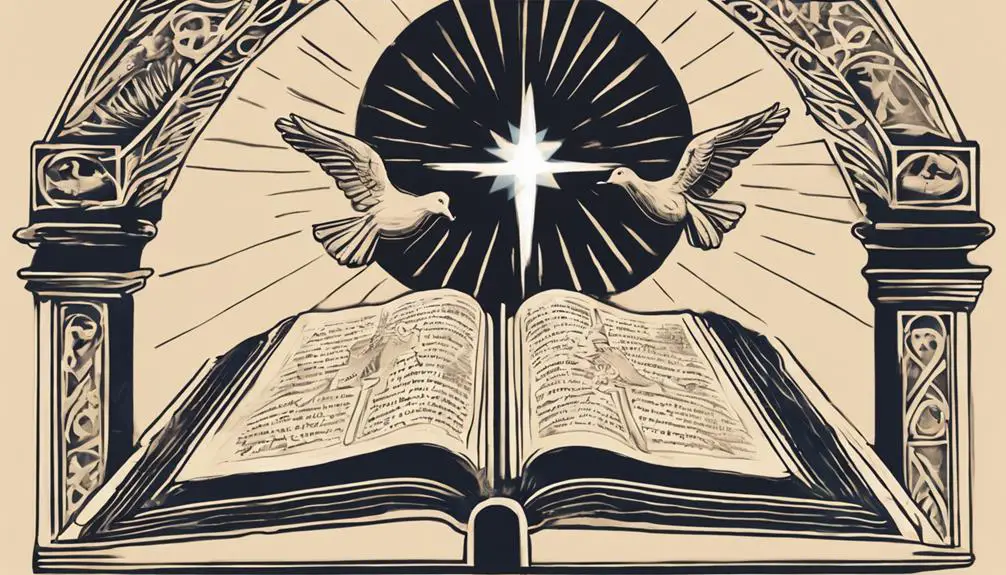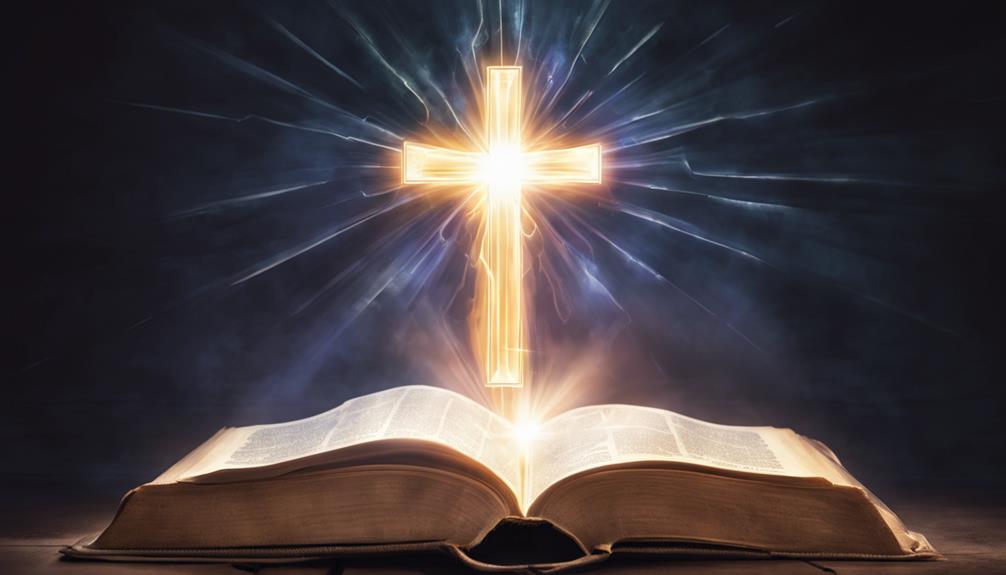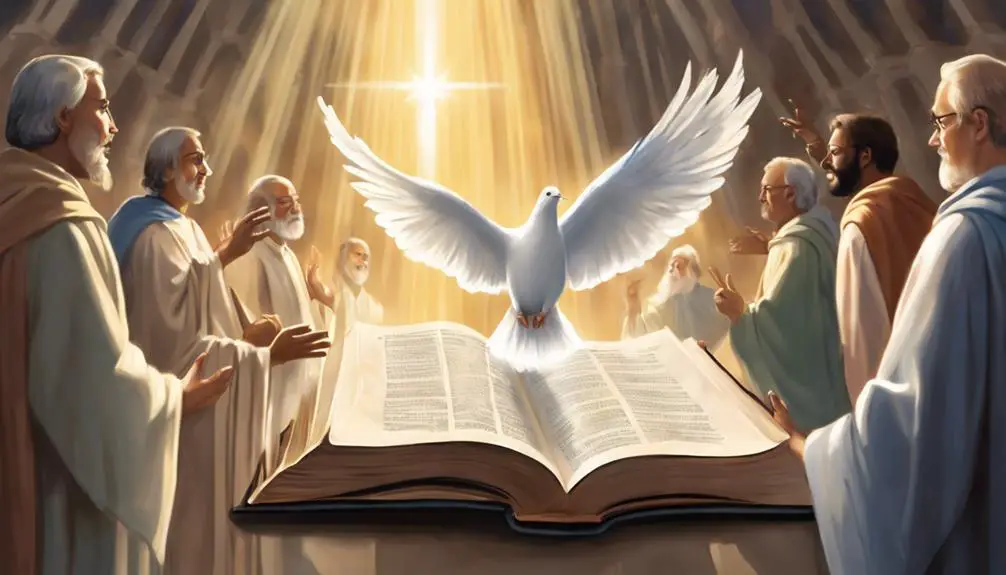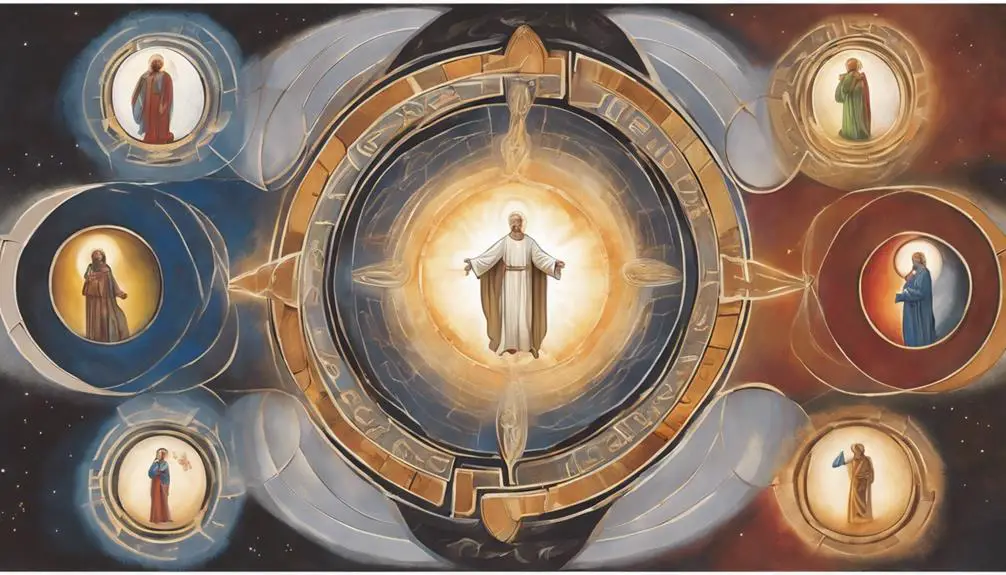Yield to the mystery of the Holy Trinity in the Bible, and unveil the subtle clues hidden within its sacred texts.

Proof of the Holy Trinity in the Bible
Did you know that 90% of Christians believe in the Holy Trinity, yet many can't pinpoint where the Bible explicitly outlines this concept?
You might find it fascinating to explore how the notion of the Trinity is woven into the scriptures, from the Genesis of Trinity concepts to Paul's letters to the Corinthians on spiritual gifts.
The baptismal instructions in Matthew and Christ's identity in John provide compelling glimpses into this doctrine, but it's the subtleties in texts like the Apostolic Greetings and Acts of the Apostles' witness that truly enrich our understanding.
Let's embark on a journey to uncover these hidden gems together, and perhaps, in the process, you'll discover something truly enlightening.
Key Takeaways
- The Council of Nicaea's affirmation of the Son's consubstantiality with the Father underscores the biblical foundation of the Trinity.
- Jesus' baptismal directive in Matthew showcases the Trinity's role in Christian initiation, reflecting its scriptural basis.
- The Gospel of John's emphasis on Jesus' divinity and unity with the Father enriches the understanding of the Trinity through scripture.
- Apostolic greetings in Pauline epistles reveal an early understanding of the distinct persons within the Godhead, supporting the Trinitarian concept.
The Genesis of Trinity Concepts

The concept of the Trinity, though not explicitly outlined in early biblical texts, emerges through a nuanced analysis of scripture that suggests a complex unity within the Godhead. As you delve into church history, you'll find that the development of Trinitarian doctrine wasn't without its challenges. Theological debates played a pivotal role in shaping the understanding of this doctrine, reflecting the early church's efforts to articulate the nature of God's unity and distinction among the Father, Son, and Holy Spirit.
In examining these debates, you'll notice that they often revolved around how to coherently maintain the oneness of God while acknowledging the scriptural attestations to the divinity of Jesus Christ and the presence of the Holy Spirit. The Council of Nicaea in 325 AD marks a significant turning point, where the Nicene Creed articulated a foundational stance on the Trinity, affirming the consubstantiality of the Son with the Father. This creed was a milestone in church history, encapsulating the outcome of theological debates and serving as a touchstone for orthodox Christian belief regarding the nature of God as a Trinity.
Baptismal Instructions in Matthew

In Matthew's Gospel, you'll encounter Jesus' directive for baptism, a pivotal moment that underscores the Trinity's integral role in Christian initiation rites. This command, found in the closing verses, not only encapsulates the essence of discipleship but also weaves the profound symbolism of water into the fabric of Christian faith. Water, as used in baptism, isn't merely a physical element; it represents purification, rebirth, and the flowing grace of the Holy Spirit.
This baptismal instruction goes beyond a simple ritual. It's a discipleship mandate, calling all followers to immerse themselves not just in water, but in the very identity of the Triune God. By invoking the names of the Father, the Son, and the Holy Spirit, Jesus doesn't just prescribe a formula; He invites believers into a relationship with the Godhead, emphasizing the unity and distinctiveness of each person in the Trinity.
Furthermore, this directive connects believers to the community of faith, past, present, and future. The act of baptism, as instructed by Jesus in Matthew, isn't an endpoint but a commencement—a beginning of a life lived in the fullness of God's triune presence, a foundational truth for every disciple's journey.
Christ's Identity in John

Exploring Christ's identity as portrayed in the Gospel of John reveals profound insights into his divine nature and mission, further illuminating the Trinity's intricate dynamics. The Gospel of John uniquely emphasizes Jesus' divinity, setting a foundational premise for understanding the Holy Trinity.
In John's narrative, you'll find that:
- Miraculous Signs are prominent, serving not just as wonders but as profound indicators of Jesus' divine authority and essence. These acts are meticulously recorded, offering you a glimpse into how Jesus' miracles validate His claims of divinity and unity with the Father.
- Jesus' Parables in John, though fewer than in the Synoptic Gospels, are rich in theological depth, unveiling layers of truth about Jesus' identity and His relationship with God the Father. Through these parables, you're invited to perceive the Kingdom of God from a perspective that intertwines the earthly with the heavenly.
- The declarations of Jesus about Himself, notably the “I Am” statements, boldly assert His divine status and eternal existence. These pronouncements not only echo the Old Testament revelation of God to Moses but also articulate Jesus' integral role within the Godhead.
In synthesizing these elements, John's Gospel offers a compelling, faith-based analysis of Christ's divine identity, enriching our understanding of the Trinity.
The Apostolic Greetings

Delving into the apostolic greetings found within the New Testament, you'll uncover a rich tapestry of early Christian thought and theology that sheds light on the nature of the Church and its foundational beliefs. Particularly, the Pauline epistles stand out for their unique greeting formulas, which aren't merely customary salutations but deeply theological statements. These greetings encapsulate the essence of the Christian message and the nature of God as understood in the early Church.
Analyzing these greetings, you'll notice how Paul emphasizes grace and peace from God our Father and the Lord Jesus Christ. This dual source of blessing reflects an early understanding of the distinct persons within the Godhead, subtly pointing towards the Trinitarian concept. Moreover, these greetings weren't just Paul's personal touch; they became a standard formula that echoed across the early Christian communities, weaving a consistent theological thread through the fabric of the nascent Church.
Through this scholarly and faith-based lens, it's clear that the apostolic greetings are far from mundane. They're a window into the profound theological underpinnings of early Christian belief, particularly the understanding of a triune God, subtly interwoven into the very introduction of each epistle.
Acts of the Apostles' Witness

The Acts of the Apostles provides a compelling narrative that showcases the early Church's witness to the power and presence of the Holy Spirit among believers. Through the vivid recounting of events such as the Pentecost and Stephen's martyrdom, you're invited to explore the foundational moments that affirm the Holy Spirit's role within the Trinity.
- Pentecost event: Acts 2 describes how the Holy Spirit descended upon the apostles, enabling them to speak in various tongues. This miraculous occurrence not only signifies the fulfillment of Jesus' promise but also marks the birth of the Church. It's a profound testament to the Holy Spirit's empowering presence, fostering unity and understanding among diverse peoples.
- Stephen's martyrdom: In Acts 7, Stephen stands as the first Christian martyr, filled with the Holy Spirit as he witnesses to the truth of Jesus Christ before the Sanhedrin. His vision of Jesus standing at the right hand of God, even as he faces death, underscores the intimate connection between the Holy Spirit and the revelation of Christ's divine authority.
- The Holy Spirit's guidance: Throughout Acts, the Holy Spirit's guidance is evident in directing the apostles' mission, confirming the Spirit's active role in the expansion of the early Church and the proclamation of the Gospel.
Corinthians on Spiritual Gifts

As we reflect on the Holy Spirit's dynamic involvement in the early Church, let's now consider how Corinthians sheds light on the diverse spiritual gifts bestowed upon believers for the common good. The Apostle Paul meticulously articulates that these gifts, though varied, originate from the same Spirit, underscoring the unity and diversity within the Church's body. This principle is essential in understanding the Holy Trinity's manifestation through spiritual gifts.
The Scriptures in Corinthians present a compelling body analogy, illustrating how each member's unique contributions are vital for the whole. Just as a body comprises different parts with distinct functions, so the Church is composed of members, each endowed with specific gifts from the Holy Spirit. These gift varieties—ranging from wisdom and knowledge to faith and healing—are not for personal glorification but serve to edify the Church and exemplify God's kingdom on Earth.
This analysis reveals a profound truth: the Holy Spirit actively distributes gifts among believers, not indiscriminately, but in a manner that promotes harmony and mutual edification. It's a testament to the unity in diversity, mirroring the relational and cooperative nature of the Holy Trinity itself.
Frequently Asked Questions
How Do Non-Trinitarian Christian Denominations Interpret the Biblical Passages Traditionally Associated With the Holy Trinity?
You're diving into how Non-Trinitarian Christian denominations view scriptures often linked with Trinitarian symbolism. These groups engage in Non-Trinitarian debates, critically analyzing biblical texts without assuming the Holy Trinity's proof.
They often interpret these passages through a lens that emphasizes the distinctness and unity of God without the Trinitarian concept. This scholarly, faith-based approach allows for a rich exploration of scripture, offering unique insights into divine nature and the interpretation of sacred texts.
Can the Doctrine of the Trinity Be Found in the Old Testament, or Is It Solely a New Testament Revelation?
You're diving into whether the Old Testament reveals the Trinity, or if it's a concept solely rooted in the New Testament. Trinitarian symbols and angelic manifestations in the Old Testament can hint at a triune God, yet interpretations vary.
Analyzing these elements requires a balance of faith and scholarship, as you sift through ancient texts. While explicit mentions are scarce, the groundwork for understanding the Trinity can be subtly found, enriching your faith journey.
How Has the Understanding of the Holy Trinity Evolved Throughout Church History Outside of Biblical Texts?
Throughout church history, your understanding of the Holy Trinity has evolved significantly. Influenced by philosophical thought and Trinitarian iconography, scholars and theologians have deepened the conceptual framework beyond biblical texts. These influences have shaped doctrines, integrating ancient philosophical insights with spiritual convictions.
This evolution reflects a dynamic journey of faith, as you've sought to articulate and visualize the mystery of the Trinity in ways that resonate with both mind and spirit.
What Are the Major Theological Debates and Councils That Shaped the Orthodox Understanding of the Trinity, and How Did They Address Dissenting Views?
You're exploring how major theological debates and councils, particularly the Arian Controversy, shaped the orthodox understanding of the Trinity.
The Council of Nicaea played a crucial role, formulating the Nicene Creed to address and reject Arian views that contested the full divinity of Christ.
This council's decisions were pivotal, laying down foundational beliefs that continue to influence Christian theology, ensuring a unified stance against dissenting interpretations.
How Do Other Major World Religions View the Christian Concept of the Holy Trinity, and What Are the Implications for Interfaith Dialogue?
You'll find that other major world religions have varied perspectives on the Christian concept of the Holy Trinity, which greatly influences interfaith dialogue. These views, shaped by cultural interpretations, can either bridge or widen gaps between faith communities.
Understanding and respecting these differences is key to fostering interfaith respect. Engaging in such dialogues with an open mind can lead to deeper insights and mutual respect among diverse religious traditions.
Conclusion
In dissecting the fabric of the Bible, you've journeyed through the foundational blocks of the Trinity concept. From Genesis to Corinthians, each testament serves as a thread, weaving a divine tapestry.
The baptismal commands in Matthew, Christ's identity in John, and the spiritual gifts in Corinthians, all highlight a triune God working in harmony. Like pieces of a puzzle coming together, these scriptures offer a compelling case for the Holy Trinity, enriching your faith and understanding with every verse analyzed.



Sign up